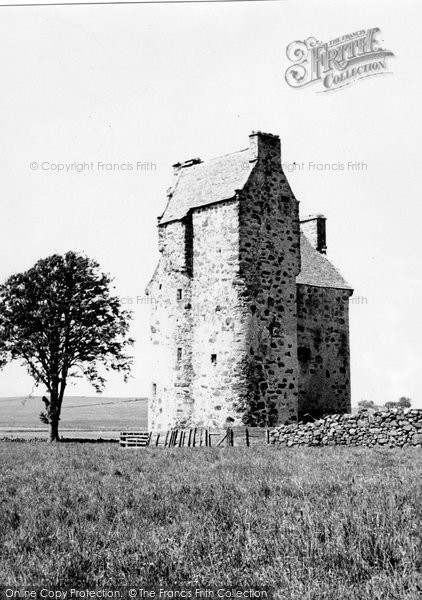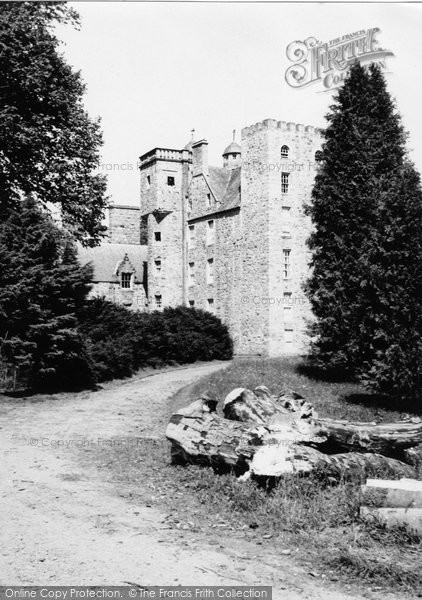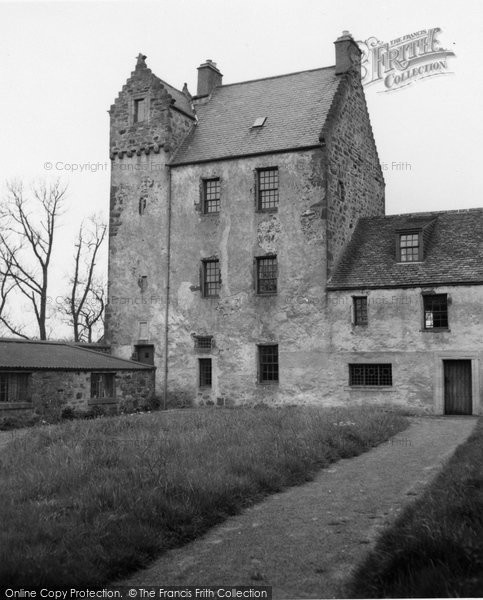Old photograph of Macduff, Aberdeenshire, Scotland. Macduff is situated on Banff Bay and faces the town of Banff across the estuary of the River Deveron. The settlement of Doune on the east bank of the river was purchased in 1733 by William Duff, who became the first Earl Fife. In 1760, James Duff, the second Earl built a harbour there and in 1783 succeeded in promoting Macduff to a Burgh of Barony. The 2nd Earl Fife appointed his factor, William Rose, as the 1st Provost of Macduff in 1783. The town celebrated its bicentenary in 1983.
All photographs are copyright of Sandy Stevenson, Tour Scotland, and may not be used without permission.
View the most recent Tour Scotland photographs.
Tour Scotland photographs and videos from my tours of Scotland. Photography and videography, both old and new, from beautiful Scotland, Scottish castles, seascapes, rivers, islands, landscapes, standing stones, lochs and glens.
Showing posts with label Tour Scotland Aberdeenshire. Show all posts
Showing posts with label Tour Scotland Aberdeenshire. Show all posts
Old Photograph North East Coast Fishing Boats Scotland

Old photograph of North East Coast Fishing Boats in Aberdeenshire, Scotland. In 1808 the entire fishing village of Footdee was moved partly to accommodate harbour expansion and partly because the residents had requested it.
All photographs are copyright of Sandy Stevenson, Tour Scotland, and may not be used without permission.
View the most recent Tour Scotland photographs.
Old Photographs Huntly Scotland

Old photograph of The Square, Huntly, Aberdeenshire, Scotland. This town was formerly known as Milton of Strathbogie.
Famous Scots from Huntly include;
William Milne, born 1785, died 1822, born at Kennethmont near Huntly, was the second British Protestant missionary to China, following Robert Morrison. He was the founding headmaster of the first Anglo-Chinese school, Ying Wa College, in 1818 at Malacca.
John Perie, born 1831, died 1874, was a recipient of the Victoria Cross, he was born in Huntly.
Ian Cameron, father of British Prime Minister, David Cameron, was from Glass, Huntly; he was born at Blairmore House.
All photographs are copyright of Sandy Stevenson, Tour Scotland, and may not be used without permission.
View the most recent Tour Scotland photographs.
Old Photograph Ravenscraig Castle Peterhead Scotland

Old photograph of Ravenscraig Castle by Peterhead, Aberdeenshire, Scotland. Ravenscraig Castle, previously the Craig of Inverugie, is a ruined L-shaped Scottish tower house, for which a licence was granted in May 1491. It is situated on the precipitous banks of the Ugie, defended by a moat.
All photographs are copyright of Sandy Stevenson, Tour Scotland, and may not be used without permission.
View the most recent Tour Scotland photographs.
Old Photograph The Square Huntly Scotland

Old photograph of The Square in Huntly, Aberdeenshire, Scotland. Huntly Square is surrounded by fine buildings many dating back to the first half of the 18th century and it has been the focal point for the inhabitants of Strathbogie and the surrounding area over the centuries. Originally a market Square by the end of the 18th century The Square was to see the livestock markets move to the edges of the town, with other forms of markets becoming less common. However the Feein’ Markets a traditional country Hiring Fair held originally for the employment of the local farm labour was not to end until the onset of the Second World War.
All photographs are copyright of Sandy Stevenson, Tour Scotland, and may not be used without permission.
View the most recent Tour Scotland photographs.
Old Photograph Abergeldie Castle Aberdeenshire Scotland

Old photograph of Abergeldie Castle, Aberdeenshire, Scotland. The earliest parts of Abergeldie Castle, which stands barely two miles from the royal family’s country home at Balmoral, date from the sixteenth century. Tour Scottish Castles.
All photographs are copyright of Sandy Stevenson, Tour Scotland, and may not be used without permission.
View the most recent Tour Scotland photographs.
Old Photograph Market Square Stonehaven Scotland

Old photograph of the Market Square, Stonehaven, Aberdeenshire, Scotland. The town lies at the southern origin of the ancient Causey Mounth trackway, which was built on high ground to make passable this only available medieval route from coastal points South to Aberdeen.
All photographs are copyright of Sandy Stevenson, Tour Scotland, and may not be used without permission.
View the most recent Tour Scotland photographs.
Old Photographs Huntly Aberdeenshire Scotland
Old photograph of Huntly, Aberdeenshire, Scotland.

Old photograph of Huntly, Aberdeenshire, Scotland.
Old photograph of Huntly Castle, Aberdeenshire, Scotland.
All photographs are copyright of Sandy Stevenson, Tour Scotland, and may not be used without permission.
View the most recent Tour Scotland photographs.
With its castle, hotels and shops, Huntly has long served as the focal point for its surrounding rural hinterland. Alan Cooper recalls erstwhile characters such as 'Pig' Murray, the town crier, and tells the story of the tinkers who used to visit the town. There was once a shoemaking factory in the Square that employed 150 people, and a brewery just outside the town that produced Strathbogie Stout. Pictures of Kennethmont and Gartly stations, along with a view of the Gartly picnic and games, draw in some locations just outside the town, although the bulk of the book covers Huntly itself. Old Huntly .
.

Old photograph of Huntly, Aberdeenshire, Scotland.
Old photograph of Huntly Castle, Aberdeenshire, Scotland.
All photographs are copyright of Sandy Stevenson, Tour Scotland, and may not be used without permission.
View the most recent Tour Scotland photographs.
With its castle, hotels and shops, Huntly has long served as the focal point for its surrounding rural hinterland. Alan Cooper recalls erstwhile characters such as 'Pig' Murray, the town crier, and tells the story of the tinkers who used to visit the town. There was once a shoemaking factory in the Square that employed 150 people, and a brewery just outside the town that produced Strathbogie Stout. Pictures of Kennethmont and Gartly stations, along with a view of the Gartly picnic and games, draw in some locations just outside the town, although the bulk of the book covers Huntly itself. Old Huntly
Old Photograph Harbour Fraserburgh Scotland

Old photograph of a fishing boat leaving the harbour in Fraserburgh, Scotland. The association of Fraserburgh with the fishing industry has been a long and committed one and up until the early 19th century the harbour consisted of a breakwater occupying the same position of the North Pier of today and a short pier to the south
All photographs are copyright of Sandy Stevenson, Tour Scotland, and may not be used without permission.
View the most recent Tour Scotland photographs.
Old Photographs Broad Street Peterhead Scotland

Old photograph of Broad Street, Peterhead, Scotland. Peterhead was a Jacobite supporting town in the Jacobite risings of 1715 and 1745. In particular, it was one of the Episcopalian North Eastern fishing ports where reinforcements, plus money and equipment, were periodically landed from France during the Forty-Five. Peterhead was founded by fishermen and was developed as a planned settlement. 1593 saw the construction of Peterhead's first harbour.
All photographs are copyright of Sandy Stevenson, Tour Scotland, and may not be used without permission.
View the most recent Tour Scotland photographs.
Old Photographs Turriff Scotland
Old photograph of houses, buildings and people in Turriff, Aberdeenshire, Scotland.

Old photograph of Turriff, Aberdeenshire, Scotland.
All photographs are copyright of Sandy Stevenson, Tour Scotland, and may not be used without permission.
View the most recent Tour Scotland photographs.

Old photograph of Turriff, Aberdeenshire, Scotland.
All photographs are copyright of Sandy Stevenson, Tour Scotland, and may not be used without permission.
View the most recent Tour Scotland photographs.
Old Photograph Travelling People Scotland

Old photograph of travelling people outside a cave in Aberdeenshire, Scotland. Scottish Travellers, or the people termed loosely gypsies and tinkers in Scotland, consist of a number of diverse, unrelated communities, speaking a variety of different languages and holding to distinct customs, histories, and traditions. There are four distinct communities that identify themselves as Gypsies or Travellers in Scotland: Indigenous Highland Travellers; Funfair Travellers, or Showmen; Romanichals, a subgroup of the Romani people; and Lowland Gypsies.
All photographs are copyright of Sandy Stevenson, Tour Scotland, and may not be used without permission.
View the most recent Tour Scotland photographs.
Old Photograph Laurencekirk Scotland

Old photograph of houses in Laurencekirk, Aberdeenshire, Scotland. Laurencekirk was, in the past, known for making snuff boxes with a special type of airtight hinge, known as a Laurencekirk hinge, invented by James Sandy.
All photographs are copyright of Sandy Stevenson, Tour Scotland, and may not be used without permission.
View the most recent Tour Scotland photographs.
Old Photographs High Street Banchory Scotland
Old photograph of shops, people and buildings on the High Street in Banchory, Aberdeenshire, Scotland. John Macqueen Cowan, born 1892, died 1960, was a prominent Scottish botanist in the mid 20th century. He was born in Banchory in northern Scotland in 1891 or 1892. He was educated at Robert Gordon's College in Aberdeen. He then attended both Edinburgh and Oxford University training as a botanist, specialising in trees, receiving a postgraduate doctorate from Oxford in 1927. From 1927 to 1929 he worked with the Indian Forest Service and conducted many studies of tree species throughout India.
All photographs are copyright of Sandy Stevenson, Tour Scotland, and may not be used without permission.
View the most recent Tour Scotland photographs.
All photographs are copyright of Sandy Stevenson, Tour Scotland, and may not be used without permission.
View the most recent Tour Scotland photographs.
Old Photograph Balfluig Castle Scotland

Reproduced courtesy of Francis Frith.
Old photograph of Balfluig Castle, Aberdeenshire, Scotland. Built in the late 16th century, this was the seat of a branch of the Forbes clan which was the pricipal clan in the Howe of Alford, but was sold to a Farquharson in 1753. Local tradition apparently relates that at one time there was another castle near enough for the respective lairds to shoot at one another from their windows, until one laird killed the other, regretting the deed for the rest of his life.
All photographs are copyright of Sandy Stevenson, Tour Scotland, and may not be used without permission.
View the most recent Tour Scotland photographs.
Old Photograph Aboyne Castle Scotland

Reproduced courtesy of Francis Frith.
Old photograph of Aboyne Castle, Aberdeenshire, Scotland. This Scottish castle was constructed by Bysets, Lords of Strathdee and Aboyne before 1233. In 1242, after the expulsion from Scotland of John and Walter Byset, who had been alleged of the murder of Patrick, Earl of Atholl, at Haddington, East Lothian, Aboyne Castle fell to ownership of the Crown and became a favourite royal residence.
All photographs are copyright of Sandy Stevenson, Tour Scotland, and may not be used without permission.
View the most recent Tour Scotland photographs.
Old Photograph Abergeldie Castle Scotland.
Old photograph of Abergeldie Castle, Aberdeenshire, Scotland. In 1481 Abergeldie passed to Sir Alexander Gordon of Midmar, first son of the 1st Earl of Huntly. The castle was built by the 4th laird of this line, Alexander, better known as Black Alister. He supported his kinsman the 4th Earl of Huntly at Corrichie in 1562 and was subsequently imprisoned by Queen Mary at St. Andrews. He took a leading part in the Gordon-Forbes feud and in 1594 his son was killed fighting the Campbells and Forbes at Glenlivet. In 1592 the castle successfully resisted a raid by the Mackintoshes and other western clans known as the Great Spulzie. When the Convenanters finally took control of Deeside in the 1640s the castle was ordered to be destroyed because Alexander, 7th laird, was an ardent Royalist, but for some reason the instruction was not executed. In 1686 Abergeldie Castle was used as a mustering point by John Graham of Claverhouse, Viscount Dundee, when he was raising a Highland army against William III. The castle was captured and garrisoned by General Mackay but it was soon blockaded by the Farquharsons and in 1690 Mackay had to come to its relief. He reported that it would have had to surrender within three more days if the garrison had not been “ timely succoured ”. When Queen Victoria and Albert began to develop neighbouring Balmoral castle as a holiday home they rented Abergeldie Castle, it being used by the then Queen Mother, the Duchess of Kent. It was later inhabited by the Princess Eugenie, widow of Napolean III, and then became the Deeside home of the Prince of Wales and his family. More recently it has been used to accommodate guests of the royal family when they were residing at Balmoral. The castle at present is occupied by the 21st Laird John Gordon, Baron of Abergeldie.
All photographs are copyright of Sandy Stevenson, Tour Scotland, and may not be used without permission.
View the most recent Tour Scotland photographs.
All photographs are copyright of Sandy Stevenson, Tour Scotland, and may not be used without permission.
View the most recent Tour Scotland photographs.
Old Photograph Kinnairdy Castle Scotland

Reproduced courtesy of Francis Frith.
Old photograph of Kinnairdy Castle, Aberdeenshire, Scotland. Aberchirder was originally a small Royal Burgh but the main town was founded in 1764. Kinnairdy Castle, belonging to the Crichton family is two miles to the south west, where the River Deveron joins the Auchintoul Burn.
All photographs are copyright of Sandy Stevenson, Tour Scotland, and may not be used without permission.
View the most recent Tour Scotland photographs.
Street View Pitsligo Castle Scotland
View Larger Map
Street view of Pitsligo Castle, Rosehearty, Aberdeenshire, Scotland. This Scottish castle originated as a 15th century keep on the south side. There is an arched gateway in the west wall of the outer court, with the date 1656 and the arms of the Forbes and Erskines. In the inner court the date is shown as 1663. At the north-east angle of the courtyard there is a tall flanking drum tower. The main tower had three vaulted stories, but almost all above the lowest has disappeared. There is a stair tower at the north-east corner which is better preserved. There are panels dated 1577 over the courtyard doorway.
All photographs are copyright of Sandy Stevenson, Tour Scotland, and may not be used without permission.
The Guide to Mysterious Aberdeenshire. A fully-illustrated guide which explores all things strange and uncanny, paranormal and peculiar in Aberdeenshire, one of the most scenic parts of Scotland, which also includes part of the Cairngorms National Park. Historic sites and ancient monuments - such as the innumerable stone circles and castles, are suveyed in an enchanting and accessible way. Descriptions of what to observe and explore are married with detailed 'site histories' of the supernatural and mysterious. These include locations of witchcraft and fairy hills, eerie contemporary sculptures and spooky long abandoned graveyards. There are tales of big cats and ape-men, murders and bodysnatching, and details of modern fire festivals, including the burning of a Wickerman. This is an indispensable companion for anyone journeying into the marvels and mysteries of Aberdeenshire. The Guide to Mysterious Aberdeenshire
Old Photograph Huntly Scotland

Old photograph of Huntly, Aberdeenshire, Scotland.
All photographs are copyright of Sandy Stevenson, Tour Scotland, and may not be used without permission.
Subscribe to:
Posts (Atom)





